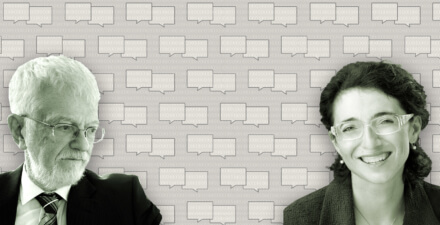Brad DeLong: Worthy reads on equitable growth, November 9–15, 2018
Worthy reads from Equitable Growth:
- The most important thing: The deadline for Equitable Growth’s next set of grant proposals is January 31, 2019: “Request for Proposals.” Also read Korin Davis, our academic programs director, who presents the backdrop to the new request for proposals: “Our grantmaking is organized around key drivers of economic growth, allowing us to ask questions to better understand the mechanisms through which inequality may be affecting growth. After 5 years of funding research, we have, for the first time, altered how we organize our grantmaking. While the underlying questions have not changed, the reorganization captures what we’ve learned about what makes the U.S. economy grow. The updated funding channels are: macroeconomic policy, market structure, the labor market, and human capital.”
- A great interview with my University of California, Berkeley colleague, the wise Hilary Hoynes, “In conversation with Hilary Hoynes,” in which she says: “Our social safety net … very much moved toward work-contingent types of activity … Some quantification or estimation of the question: Does providing more assistance through the social safety net, particularly aimed at children, lead to differences in where children end up in adulthood?”
- We have a new blog at Equitable Growth! Hooray! Read this week’s “Competitive Edge,” featuring former Commissioner of the Federal Trade Commission Terrell McSweeney, who writes in “Competitive Edge: Antitrust Enforcers Need Reinforcements to Keep Pace with Algorithms, Machine Learning, and Artificial Intelligence” that: “Algorithmic price fixing isn’t science fiction. The U.S. Department of Justice’s Antitrust Division and the United Kingdom’s Competition and Markets Authority have already brought their first case in which competitors agreed to use specific pricing algorithms for the sale of posters online. This particular case did not stretch the traditional antitrust framework for price fixing because humans were involved. But as technology becomes more powerful and autonomous, some competition experts are raising concerns about whether analog antitrust doctrines can keep pace.”
- Read Delany Crampton, “Veterans in the U.S. Labor Market Face Barriers to Success That Can and Should Be Addressed,” in which he writes: “Anna Zogas of the University of Washington observes in her 2017 research that the U.S. military does an extremely effective job of training veterans to operate within the military and an extremely poor job of preparing them, especially young servicemembers, for post-military jobs.”
- Watch the video via Equitable Growth’s Twitter feed of its event on Capitol Hill, “Building a New Consensus on Antitrust Reform.”
Worthy reads not from Equitable Growth:
- Read Ken Kuttner, “Outside the Box: Unconventional Monetary Policy in the Great Recession and Beyond,” in which he writes: “A preponderance of evidence nonetheless suggests that forward guidance and quantitative easing succeeded in lowering long-term interest rates. Studies using micro data have documented tangible effects of quantitative easing on firms and financial intermediaries. Macro models suggest that the interest rate reductions are likely to have had a meaningful impact. The adverse side effects appear to have been mild, and are dwarfed by the costs of the more protracted recession in the United States that likely would have occurred in the absence of the unconventional policies. The benefits of unconventional policy therefore probably outweighed the costs.” My read of the evidence is somewhat different here: My view is that forward guidance did something, but quantitative easing did very, very little. And the idea that quantitative easing made forward guidance more credible? I do not see that. Yes, quantitative easing was a big deal for the financial professionals who otherwise would have held the Treasury bonds that the Federal Reserve bought. But I do not see any channels through which their attempt to compensate had large effects on the real economy of production and demand.
- Since 2008, it is clear to me that the unemployment rate has no longer served as a sufficient statistic for whether the labor market is loose or tight. We need to look, and look hard, at those who do not have jobs and do not say that they are looking for jobs but who would take jobs if they existed. And we need to look very hard at hours. Read David Bell and David Blanchflower, “Underemployment in the US and Europe,” in which they write: “The most widely available measure of underemployment is the share of involuntary part-time workers in total employment. This column argues that this does not fully capture the extent of worker dissatisfaction with currently contracted hours. An underemployment index measuring how many extra or fewer hours individuals would like to work suggests that the U.S. and the U.K. are a long way from full employment, and that policymakers should not be focused on the unemployment rate in the years after a recession, but rather on the underemployment rate.”
- Dan Davies on financial fraud is certainly the most entertaining book on economics I have read this year. I highly recommend it. Read Chris Dillow’s “Review of Dan Davies: Lying for Money,” in which Dillow writes: “Squalid crude affairs committed mostly by inadequates. This is a message of Dan Davies’ history of fraud, Lying For Money … Most frauds fall into a few simple types … Setting up a fake company … pyramid schemes … control frauds, whereby someone abuses a position of trust … plain counterfeiters. My favourite was Alves dos Reis, who persuaded the printers of legitimate Portuguese banknotes to print even more of them … All this is done with the wit and clarity of exposition for which we have long admired Dan. His footnotes are an especial delight, reminding me of William Donaldson. Dan has also a theory of fraud. ‘The optimal level of fraud is unlikely to be zero’ he says. If we were to take so many precautions to stop it, we would also strangle legitimate economic activity.”
- Read the 2001 paper by Thomas Laubach and John C. Williams, “Measuring the Natural Rate of Interest,” in which they write: “A key variable for the conduct of monetary policy is the natural rate of interest—the real interest rate consistent with output equaling potential and stable inflation. Economic theory implies that the natural rate of interest varies over time.” The assumption driving the argument here is that the natural rate of interest varies one for one with productivity growth. That is probably right, but not certainly right. If it is right, the Federal Reserve’s 2 percent inflation rate target is a huge mistake generating huge risks.
- It is such a bad idea for a central bank to invert the yield curve. If central bankers can do only one thing, that is probably the thing they should know. Read Glenn D. Rudebusch and John C. Williams, “Forecasting Recessions: The Puzzle of the Enduring Power of the Yield Curve,” in which they write: “For over two decades, researchers have provided evidence that the yield curve … contains useful information for signaling future recessions. … Professional forecasters appear worse at predicting recessions a few quarters ahead than a simple real-time forecasting model that is based on the yield spread.”
- It is a surprise to most economists to learn that the outbreak of inflation in the 1970s was not due to central bankers and governments trying to exploit the Phillips curve to run a high-pressure economy. The most important shocks were the oil shocks. The second most important shocks were those that caused the productivity growth slowdown. The third most important shocks were Presidents Lyndon Johnson’s and Richard Nixon’s unwillingness to listen to their economic advisers, and Federal Reserve Board Chairmen William McChesney Martin’s and Arthur Burns’ unwillingness to pull a Volcker. Perhaps it is because it is such a surprise that so few have learned it and how many forget it immediately after it is pointed out. And since the 1970s, the strong belief that another 1970s is always and everywhere lurking around the corner has been very damaging. Read Paul Krugman, “The Demand-Side Temptation,” in which he writes: “[Nick] Rowe goes on to suggest that demand-side logic is dangerous … could lead to irresponsible policies. Well, there have been times and places … But what I think Nick misses is the power of the contrary narrative, of the notion of the government as being like a family that must tighten its belt when the rest of us do, of the evils of printing money (hey, I can’t do that, why can Bernanke?).”




